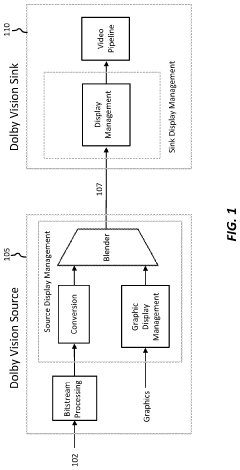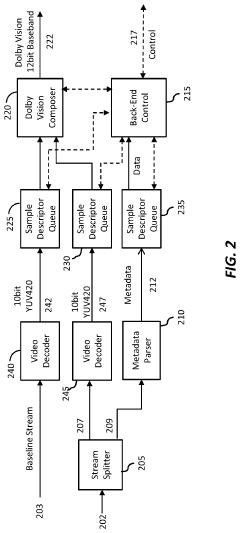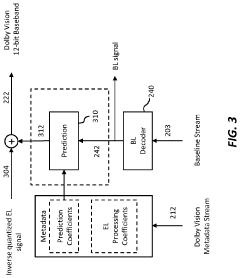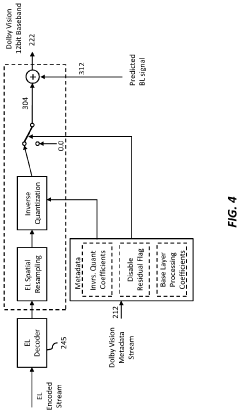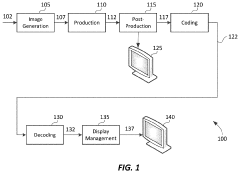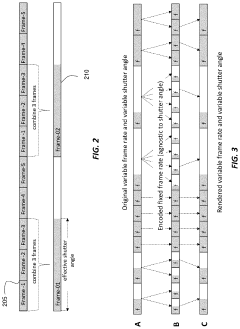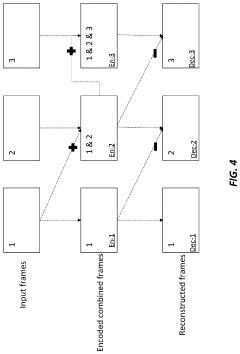Dolby Vision in Next-Generation Broadcast Technologies
JUL 30, 20259 MIN READ
Generate Your Research Report Instantly with AI Agent
Patsnap Eureka helps you evaluate technical feasibility & market potential.
Dolby Vision Evolution and Objectives
Dolby Vision, a cutting-edge High Dynamic Range (HDR) technology, has undergone significant evolution since its inception in 2014. Initially developed to enhance the visual experience in cinema, it has rapidly expanded into consumer electronics, including televisions, smartphones, and tablets. The primary objective of Dolby Vision has been to deliver a more immersive and lifelike viewing experience by dramatically improving contrast, color accuracy, and brightness.
The evolution of Dolby Vision has been marked by several key milestones. In its early stages, the technology focused on expanding the color gamut and increasing peak brightness levels. As it progressed, Dolby Vision introduced dynamic metadata, allowing for frame-by-frame optimization of HDR content. This advancement significantly improved the accuracy of HDR rendering across various display devices.
More recently, Dolby Vision has set its sights on addressing the challenges posed by next-generation broadcast technologies. With the advent of 4K and 8K broadcasting, the demand for efficient HDR delivery has intensified. Dolby Vision's objectives in this context include developing more robust compression algorithms to enable high-quality HDR transmission within limited bandwidth constraints.
Another critical goal for Dolby Vision in the broadcast sector is to ensure backward compatibility with existing SDR (Standard Dynamic Range) systems. This objective is crucial for broadcasters who need to cater to both HDR-capable and legacy displays simultaneously. Dolby Vision aims to provide a single stream solution that can be decoded appropriately by different devices, streamlining the broadcast workflow.
In the realm of live broadcasting, Dolby Vision is working towards real-time HDR processing capabilities. This involves developing tools and workflows that allow for on-the-fly HDR grading and metadata generation, essential for live sports and events. The technology aims to maintain consistent quality across various viewing environments, from professional broadcast monitors to consumer devices.
Looking ahead, Dolby Vision's objectives include further integration with emerging technologies such as 5G broadcasting and cloud-based content delivery. The goal is to optimize HDR content delivery across diverse network conditions and device capabilities. Additionally, Dolby Vision is exploring ways to enhance its AI-driven scene analysis and metadata generation, aiming to automate and improve the HDR mastering process for a wide range of content types.
As next-generation broadcast technologies continue to evolve, Dolby Vision's roadmap includes adapting to higher frame rates and exploring ways to incorporate additional sensory experiences, potentially integrating with other Dolby technologies like Atmos for a more holistic audiovisual experience. The overarching aim remains to push the boundaries of visual fidelity while ensuring practical implementation across the broadcast ecosystem.
The evolution of Dolby Vision has been marked by several key milestones. In its early stages, the technology focused on expanding the color gamut and increasing peak brightness levels. As it progressed, Dolby Vision introduced dynamic metadata, allowing for frame-by-frame optimization of HDR content. This advancement significantly improved the accuracy of HDR rendering across various display devices.
More recently, Dolby Vision has set its sights on addressing the challenges posed by next-generation broadcast technologies. With the advent of 4K and 8K broadcasting, the demand for efficient HDR delivery has intensified. Dolby Vision's objectives in this context include developing more robust compression algorithms to enable high-quality HDR transmission within limited bandwidth constraints.
Another critical goal for Dolby Vision in the broadcast sector is to ensure backward compatibility with existing SDR (Standard Dynamic Range) systems. This objective is crucial for broadcasters who need to cater to both HDR-capable and legacy displays simultaneously. Dolby Vision aims to provide a single stream solution that can be decoded appropriately by different devices, streamlining the broadcast workflow.
In the realm of live broadcasting, Dolby Vision is working towards real-time HDR processing capabilities. This involves developing tools and workflows that allow for on-the-fly HDR grading and metadata generation, essential for live sports and events. The technology aims to maintain consistent quality across various viewing environments, from professional broadcast monitors to consumer devices.
Looking ahead, Dolby Vision's objectives include further integration with emerging technologies such as 5G broadcasting and cloud-based content delivery. The goal is to optimize HDR content delivery across diverse network conditions and device capabilities. Additionally, Dolby Vision is exploring ways to enhance its AI-driven scene analysis and metadata generation, aiming to automate and improve the HDR mastering process for a wide range of content types.
As next-generation broadcast technologies continue to evolve, Dolby Vision's roadmap includes adapting to higher frame rates and exploring ways to incorporate additional sensory experiences, potentially integrating with other Dolby technologies like Atmos for a more holistic audiovisual experience. The overarching aim remains to push the boundaries of visual fidelity while ensuring practical implementation across the broadcast ecosystem.
Broadcast Market Demand Analysis
The broadcast market is experiencing a significant shift towards advanced video technologies, with Dolby Vision emerging as a key player in next-generation broadcast systems. As consumers increasingly demand higher quality viewing experiences, broadcasters and content providers are under pressure to adopt cutting-edge technologies that can deliver superior image quality and immersive experiences.
The global broadcast market is projected to grow substantially in the coming years, driven by the increasing adoption of 4K and 8K resolution displays, as well as the rising popularity of HDR content. Dolby Vision, as a premium HDR format, is well-positioned to capitalize on this growth trend. The technology's ability to enhance contrast, color accuracy, and overall picture quality aligns perfectly with the market's demand for more lifelike and engaging visual experiences.
In the traditional broadcast sector, there is a growing need for technologies that can optimize content delivery across various platforms and devices. Dolby Vision's scalable approach to HDR content creation and distribution makes it an attractive option for broadcasters looking to future-proof their content while maintaining compatibility with existing systems. This adaptability is crucial in a market where viewers consume content across a wide range of devices, from large-screen TVs to mobile phones.
The rise of streaming services has also created new opportunities for advanced broadcast technologies. As major streaming platforms compete for subscribers, the integration of premium video technologies like Dolby Vision becomes a key differentiator. This has led to increased demand for Dolby Vision-enabled content and compatible devices, further driving market growth.
Sports broadcasting, in particular, stands to benefit significantly from Dolby Vision technology. The enhanced dynamic range and color accuracy can greatly improve the viewing experience for live sports events, potentially increasing viewer engagement and retention. This presents a substantial market opportunity, given the high value placed on sports content by broadcasters and advertisers alike.
The automotive industry's growing interest in in-vehicle entertainment systems also represents an emerging market for advanced broadcast technologies. As vehicles become more autonomous, the demand for high-quality video content in cars is expected to rise, creating new avenues for Dolby Vision implementation.
However, the adoption of Dolby Vision in broadcast technologies also faces challenges. The cost of upgrading existing infrastructure and the need for widespread device compatibility are potential barriers to market penetration. Additionally, competing HDR standards and the ongoing development of new video technologies create a complex landscape for broadcasters and content creators to navigate.
The global broadcast market is projected to grow substantially in the coming years, driven by the increasing adoption of 4K and 8K resolution displays, as well as the rising popularity of HDR content. Dolby Vision, as a premium HDR format, is well-positioned to capitalize on this growth trend. The technology's ability to enhance contrast, color accuracy, and overall picture quality aligns perfectly with the market's demand for more lifelike and engaging visual experiences.
In the traditional broadcast sector, there is a growing need for technologies that can optimize content delivery across various platforms and devices. Dolby Vision's scalable approach to HDR content creation and distribution makes it an attractive option for broadcasters looking to future-proof their content while maintaining compatibility with existing systems. This adaptability is crucial in a market where viewers consume content across a wide range of devices, from large-screen TVs to mobile phones.
The rise of streaming services has also created new opportunities for advanced broadcast technologies. As major streaming platforms compete for subscribers, the integration of premium video technologies like Dolby Vision becomes a key differentiator. This has led to increased demand for Dolby Vision-enabled content and compatible devices, further driving market growth.
Sports broadcasting, in particular, stands to benefit significantly from Dolby Vision technology. The enhanced dynamic range and color accuracy can greatly improve the viewing experience for live sports events, potentially increasing viewer engagement and retention. This presents a substantial market opportunity, given the high value placed on sports content by broadcasters and advertisers alike.
The automotive industry's growing interest in in-vehicle entertainment systems also represents an emerging market for advanced broadcast technologies. As vehicles become more autonomous, the demand for high-quality video content in cars is expected to rise, creating new avenues for Dolby Vision implementation.
However, the adoption of Dolby Vision in broadcast technologies also faces challenges. The cost of upgrading existing infrastructure and the need for widespread device compatibility are potential barriers to market penetration. Additionally, competing HDR standards and the ongoing development of new video technologies create a complex landscape for broadcasters and content creators to navigate.
Dolby Vision Technical Challenges
Dolby Vision faces several technical challenges in the context of next-generation broadcast technologies. One of the primary obstacles is the increased bandwidth requirement for transmitting high dynamic range (HDR) content. Dolby Vision's advanced metadata and enhanced color depth necessitate a higher bitrate compared to standard dynamic range (SDR) content, potentially straining existing broadcast infrastructure.
Another significant challenge lies in the complexity of implementing Dolby Vision across diverse display technologies. As broadcasters aim to deliver consistent viewing experiences, they must account for a wide range of consumer devices with varying capabilities. This includes legacy SDR displays, HDR10-compatible screens, and Dolby Vision-enabled televisions. Ensuring optimal performance across this heterogeneous ecosystem demands sophisticated content adaptation and dynamic metadata management.
The real-time processing of Dolby Vision content presents additional hurdles for live broadcast scenarios. The computational demands of encoding and transmitting HDR content with frame-by-frame metadata in real-time can be substantial, requiring powerful hardware and efficient algorithms. This challenge is particularly acute for sports and other live events where low latency is crucial.
Interoperability and standardization pose ongoing challenges for Dolby Vision in the broadcast landscape. While Dolby Vision has gained significant traction, it competes with other HDR formats like HDR10+ and HLG. Broadcasters must navigate this fragmented ecosystem, potentially supporting multiple HDR formats to ensure broad compatibility, which increases complexity and costs.
Content creation and mastering for Dolby Vision also present technical hurdles. The production workflow must accommodate the expanded color gamut and dynamic range, requiring specialized equipment and expertise. This includes HDR-capable cameras, monitors, and post-production tools, as well as trained professionals who can effectively utilize these resources to create compelling Dolby Vision content.
Lastly, the challenge of backward compatibility remains significant. Broadcasters must develop efficient methods to simultaneously deliver Dolby Vision content to compatible displays while providing a high-quality experience to SDR viewers. This dual-stream approach, often involving complex tone-mapping and dynamic range compression, adds another layer of technical complexity to the broadcast pipeline.
Another significant challenge lies in the complexity of implementing Dolby Vision across diverse display technologies. As broadcasters aim to deliver consistent viewing experiences, they must account for a wide range of consumer devices with varying capabilities. This includes legacy SDR displays, HDR10-compatible screens, and Dolby Vision-enabled televisions. Ensuring optimal performance across this heterogeneous ecosystem demands sophisticated content adaptation and dynamic metadata management.
The real-time processing of Dolby Vision content presents additional hurdles for live broadcast scenarios. The computational demands of encoding and transmitting HDR content with frame-by-frame metadata in real-time can be substantial, requiring powerful hardware and efficient algorithms. This challenge is particularly acute for sports and other live events where low latency is crucial.
Interoperability and standardization pose ongoing challenges for Dolby Vision in the broadcast landscape. While Dolby Vision has gained significant traction, it competes with other HDR formats like HDR10+ and HLG. Broadcasters must navigate this fragmented ecosystem, potentially supporting multiple HDR formats to ensure broad compatibility, which increases complexity and costs.
Content creation and mastering for Dolby Vision also present technical hurdles. The production workflow must accommodate the expanded color gamut and dynamic range, requiring specialized equipment and expertise. This includes HDR-capable cameras, monitors, and post-production tools, as well as trained professionals who can effectively utilize these resources to create compelling Dolby Vision content.
Lastly, the challenge of backward compatibility remains significant. Broadcasters must develop efficient methods to simultaneously deliver Dolby Vision content to compatible displays while providing a high-quality experience to SDR viewers. This dual-stream approach, often involving complex tone-mapping and dynamic range compression, adds another layer of technical complexity to the broadcast pipeline.
Current Dolby Vision Implementation
01 High Dynamic Range (HDR) Technology
Dolby Vision utilizes HDR technology to enhance image quality by expanding the range of both contrast and color. This results in brighter highlights, deeper blacks, and a wider color gamut, providing a more lifelike and immersive viewing experience.- High Dynamic Range (HDR) Technology: Dolby Vision utilizes HDR technology to enhance image quality by expanding the range of both contrast and color. This results in brighter highlights, deeper blacks, and a wider color gamut, providing a more lifelike and immersive viewing experience.
- Dynamic Metadata Processing: Dolby Vision employs dynamic metadata processing to optimize image quality on a frame-by-frame or scene-by-scene basis. This allows for precise control over brightness, contrast, and color, ensuring that each frame is displayed at its best possible quality.
- Color Mapping and Calibration: Advanced color mapping and calibration techniques are used in Dolby Vision to ensure accurate color reproduction across different display devices. This includes methods for adapting content to the specific capabilities of each display, maintaining color consistency and image fidelity.
- Content Creation and Mastering: Dolby Vision incorporates specialized tools and workflows for content creation and mastering. These enable filmmakers and content producers to capture, process, and deliver high-quality HDR content that fully utilizes the capabilities of Dolby Vision-enabled displays.
- Display Device Optimization: Techniques for optimizing display devices to support Dolby Vision, including methods for enhancing local dimming, improving color accuracy, and increasing peak brightness. These optimizations help to fully realize the potential of Dolby Vision content on compatible displays.
02 Dynamic Metadata Processing
Dolby Vision employs dynamic metadata processing to optimize image quality on a scene-by-scene or frame-by-frame basis. This allows for precise control over brightness, color, and contrast, ensuring that each image is displayed at its best possible quality.Expand Specific Solutions03 Color Grading and Mapping
Advanced color grading and mapping techniques are used in Dolby Vision to accurately reproduce colors across different display devices. This ensures consistent color representation and maintains the creator's artistic intent, regardless of the viewing device's capabilities.Expand Specific Solutions04 Display Calibration and Optimization
Dolby Vision incorporates display calibration and optimization algorithms to adapt content to the specific characteristics of individual displays. This process helps to maximize image quality by accounting for factors such as peak brightness, color gamut, and local dimming capabilities of the display.Expand Specific Solutions05 Content Creation and Mastering Tools
Specialized content creation and mastering tools are developed for Dolby Vision to ensure high-quality image production. These tools allow content creators to fine-tune HDR content, preserving detail in both highlights and shadows, and enabling precise color grading for optimal visual quality.Expand Specific Solutions
Key Players in Dolby Vision Ecosystem
The research on Dolby Vision in next-generation broadcast technologies is at a critical juncture, with the market poised for significant growth. The industry is transitioning from early adoption to mainstream implementation, driven by increasing demand for high-quality visual experiences. Major players like LG Electronics, Samsung, Sony, and Dolby Laboratories are leading the charge, investing heavily in R&D and product development. The technology's maturity is rapidly advancing, with companies like Toshiba, Philips, and Pioneer also contributing to its evolution. As the ecosystem expands, collaborations between tech giants and content providers are accelerating the technology's integration across various platforms, setting the stage for widespread adoption in the coming years.
LG Electronics, Inc.
Technical Solution: LG has been actively researching and implementing Dolby Vision in its next-generation broadcast technologies. The company's OLED TVs are known for their superior HDR performance, with perfect blacks and high contrast ratios that complement Dolby Vision capabilities[12]. LG has developed its α9 Gen 4 AI Processor, which uses deep learning algorithms to analyze and optimize Dolby Vision content in real-time, enhancing picture quality based on the viewing environment[13]. In the broadcast space, LG has partnered with major content providers to ensure a wide range of Dolby Vision content is available to consumers. The company has also been working on integrating Dolby Vision IQ, which adjusts HDR performance based on ambient light conditions, into its broadcast-ready TV models[14].
Strengths: Superior OLED display technology, advanced AI processing for HDR content. Weaknesses: Heavy reliance on Dolby Vision may limit flexibility with other HDR formats.
Samsung Electronics Co., Ltd.
Technical Solution: Samsung has developed its own HDR10+ technology as an alternative to Dolby Vision for next-generation broadcasting. HDR10+ uses dynamic metadata similar to Dolby Vision but is based on an open, royalty-free standard[5]. Samsung's approach supports up to 4,000 nits peak brightness and 10-bit color depth, offering significant improvements over standard HDR10[6]. The company has integrated HDR10+ into its QLED TV lineup and has partnered with other manufacturers to expand the technology's adoption[7]. Samsung has also developed AI-powered upscaling techniques to enhance SDR content to near-HDR quality, improving the viewing experience for legacy content in next-generation broadcast environments[8].
Strengths: Open standard, no licensing fees, strong TV market presence. Weaknesses: Less widespread adoption compared to Dolby Vision, slightly lower technical specifications.
Core Dolby Vision Innovations
Layered representation and delivery of high dynamic range video
PatentActiveUS20190373290A1
Innovation
- The implementation of a layered representation and delivery system for HDR video, utilizing Dolby Vision technology, which includes a base layer and enhancement layer, along with metadata processing to reconstruct HDR signals, ensuring seamless playback on compatible displays.
Frame-rate scalable video coding
PatentActiveUS11936888B1
Innovation
- The development of frame-rate scalable video coding techniques that allow for the encoding and decoding of video content at various frame rates and shutter angles, enabling the creation of a single version of HDR content that can be rendered compatible with a range of devices by combining and duplicating frames, while signaling metadata for efficient processing.
Broadcast Standards Integration
The integration of Dolby Vision into next-generation broadcast standards represents a significant advancement in the delivery of high-quality video content. As broadcasters and content providers seek to enhance viewer experiences, the incorporation of Dolby Vision's HDR technology into existing and emerging broadcast standards has become a focal point of industry discussions and technological development.
Current broadcast standards, such as ATSC 3.0 and DVB-T2, are already capable of supporting HDR content, but the specific implementation of Dolby Vision requires careful consideration and standardization. The process of integrating Dolby Vision into these standards involves addressing several key aspects, including metadata handling, backward compatibility, and bandwidth optimization.
One of the primary challenges in this integration is ensuring that Dolby Vision's dynamic metadata can be efficiently transmitted within the constraints of broadcast bandwidth. This requires the development of robust compression techniques and intelligent metadata management systems that can adapt to varying network conditions while maintaining the integrity of the HDR image.
Interoperability is another crucial factor in the successful integration of Dolby Vision into broadcast standards. As different regions and broadcasters may adopt various HDR formats, it is essential to establish a framework that allows for seamless coexistence of Dolby Vision with other HDR technologies, such as HDR10+ and HLG. This involves creating standardized conversion processes and ensuring that receivers can correctly interpret and display content regardless of the specific HDR format used.
The integration efforts also extend to the production and post-production workflows. Broadcast standards must accommodate the unique requirements of Dolby Vision content creation, including support for higher bit depths, wider color gamuts, and the preservation of creative intent throughout the broadcast chain. This necessitates updates to existing production tools and the development of new quality control mechanisms to ensure that the Dolby Vision experience is maintained from creation to delivery.
As the integration progresses, standardization bodies are working closely with Dolby Laboratories to define the technical specifications and implementation guidelines for Dolby Vision in broadcast environments. This collaboration aims to create a unified approach that can be adopted globally, facilitating the widespread deployment of Dolby Vision-enabled broadcast services.
The successful integration of Dolby Vision into broadcast standards has the potential to revolutionize the television viewing experience, offering consumers unprecedented image quality and creative expression. As this technology becomes more prevalent in broadcast ecosystems, it will likely drive the adoption of HDR-capable displays and set-top boxes, further accelerating the transition to next-generation video experiences in homes worldwide.
Current broadcast standards, such as ATSC 3.0 and DVB-T2, are already capable of supporting HDR content, but the specific implementation of Dolby Vision requires careful consideration and standardization. The process of integrating Dolby Vision into these standards involves addressing several key aspects, including metadata handling, backward compatibility, and bandwidth optimization.
One of the primary challenges in this integration is ensuring that Dolby Vision's dynamic metadata can be efficiently transmitted within the constraints of broadcast bandwidth. This requires the development of robust compression techniques and intelligent metadata management systems that can adapt to varying network conditions while maintaining the integrity of the HDR image.
Interoperability is another crucial factor in the successful integration of Dolby Vision into broadcast standards. As different regions and broadcasters may adopt various HDR formats, it is essential to establish a framework that allows for seamless coexistence of Dolby Vision with other HDR technologies, such as HDR10+ and HLG. This involves creating standardized conversion processes and ensuring that receivers can correctly interpret and display content regardless of the specific HDR format used.
The integration efforts also extend to the production and post-production workflows. Broadcast standards must accommodate the unique requirements of Dolby Vision content creation, including support for higher bit depths, wider color gamuts, and the preservation of creative intent throughout the broadcast chain. This necessitates updates to existing production tools and the development of new quality control mechanisms to ensure that the Dolby Vision experience is maintained from creation to delivery.
As the integration progresses, standardization bodies are working closely with Dolby Laboratories to define the technical specifications and implementation guidelines for Dolby Vision in broadcast environments. This collaboration aims to create a unified approach that can be adopted globally, facilitating the widespread deployment of Dolby Vision-enabled broadcast services.
The successful integration of Dolby Vision into broadcast standards has the potential to revolutionize the television viewing experience, offering consumers unprecedented image quality and creative expression. As this technology becomes more prevalent in broadcast ecosystems, it will likely drive the adoption of HDR-capable displays and set-top boxes, further accelerating the transition to next-generation video experiences in homes worldwide.
Content Creation Workflow Impact
The integration of Dolby Vision into next-generation broadcast technologies has significantly impacted the content creation workflow, revolutionizing the way high-quality video content is produced and delivered. This advanced HDR technology has necessitated changes in various stages of content production, from capture to post-production and distribution.
At the capture stage, cinematographers and camera operators now need to consider the expanded dynamic range and color gamut offered by Dolby Vision. This requires careful attention to lighting setups and exposure settings to fully utilize the technology's capabilities. Cameras capable of capturing high dynamic range footage have become essential tools in the production arsenal, with manufacturers developing new models specifically designed to support Dolby Vision workflows.
In post-production, color grading has become a more intricate process. Colorists must now work with a wider range of luminance and color values, requiring specialized monitors and software that can accurately display and manipulate Dolby Vision content. The introduction of trim passes has added an extra layer to the grading process, allowing for the creation of multiple versions optimized for different display capabilities while maintaining the creative intent across all formats.
The editing phase has also seen changes, with non-linear editing systems adapting to handle Dolby Vision metadata. Editors must now consider how their cuts and transitions will affect the dynamic range and color information throughout the timeline. This has led to the development of new plugins and tools specifically designed for Dolby Vision editing workflows.
Visual effects and compositing workflows have been similarly affected. VFX artists must now create assets that can take full advantage of the expanded color and brightness range, ensuring that CGI elements seamlessly integrate with live-action footage in HDR environments. This has driven advancements in rendering technologies and compositing software to support the increased color depth and luminance values.
The mastering process has become more complex, requiring the creation of multiple deliverables to cater to various distribution channels and display capabilities. Content creators must now produce Dolby Vision masters alongside standard dynamic range versions, necessitating efficient workflows to manage these parallel processes without significantly increasing production time or costs.
Quality control procedures have also evolved to accommodate Dolby Vision content. New tools and processes have been developed to verify the integrity of HDR metadata and ensure that the content displays correctly across a wide range of devices, from high-end televisions to mobile phones supporting Dolby Vision playback.
At the capture stage, cinematographers and camera operators now need to consider the expanded dynamic range and color gamut offered by Dolby Vision. This requires careful attention to lighting setups and exposure settings to fully utilize the technology's capabilities. Cameras capable of capturing high dynamic range footage have become essential tools in the production arsenal, with manufacturers developing new models specifically designed to support Dolby Vision workflows.
In post-production, color grading has become a more intricate process. Colorists must now work with a wider range of luminance and color values, requiring specialized monitors and software that can accurately display and manipulate Dolby Vision content. The introduction of trim passes has added an extra layer to the grading process, allowing for the creation of multiple versions optimized for different display capabilities while maintaining the creative intent across all formats.
The editing phase has also seen changes, with non-linear editing systems adapting to handle Dolby Vision metadata. Editors must now consider how their cuts and transitions will affect the dynamic range and color information throughout the timeline. This has led to the development of new plugins and tools specifically designed for Dolby Vision editing workflows.
Visual effects and compositing workflows have been similarly affected. VFX artists must now create assets that can take full advantage of the expanded color and brightness range, ensuring that CGI elements seamlessly integrate with live-action footage in HDR environments. This has driven advancements in rendering technologies and compositing software to support the increased color depth and luminance values.
The mastering process has become more complex, requiring the creation of multiple deliverables to cater to various distribution channels and display capabilities. Content creators must now produce Dolby Vision masters alongside standard dynamic range versions, necessitating efficient workflows to manage these parallel processes without significantly increasing production time or costs.
Quality control procedures have also evolved to accommodate Dolby Vision content. New tools and processes have been developed to verify the integrity of HDR metadata and ensure that the content displays correctly across a wide range of devices, from high-end televisions to mobile phones supporting Dolby Vision playback.
Unlock deeper insights with Patsnap Eureka Quick Research — get a full tech report to explore trends and direct your research. Try now!
Generate Your Research Report Instantly with AI Agent
Supercharge your innovation with Patsnap Eureka AI Agent Platform!
